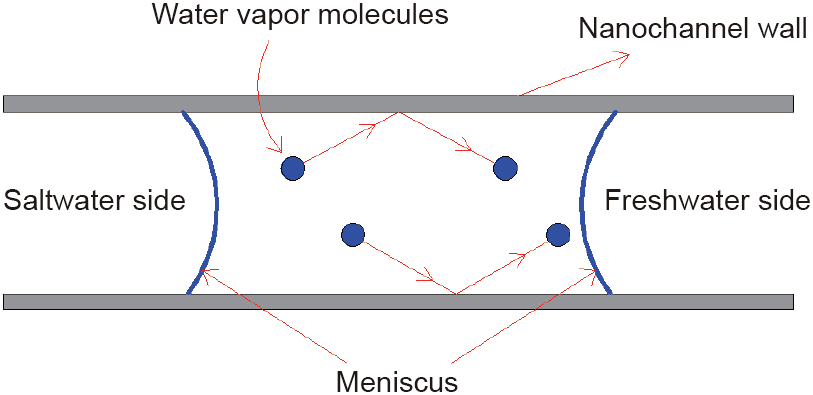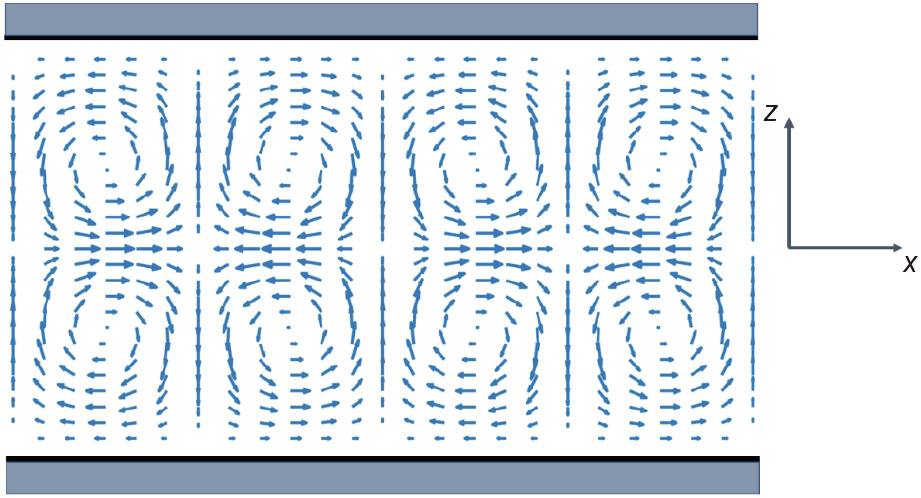Interfaces define the bulk. It is widely known that many interesting phenomena occur at the interfaces separating two homogeneous phases of matter. In this opinion piece, I wish to call attention to two recent developments that involve at least one interface. The first development is in desalination—a topic of practical importance in view of the steadily eroding global freshwater supply. The second development involves the use of hydrodynamic eigenmodes to not only determine the position of the hydrodynamic boundary in channel flows—a somewhat surprising proposition, since that position does not coincide with the solid/liquid interface—but also obtain an alternative perspective on thermal fluctuations and their linkage to hydrodynamic boundary conditions in a mesoscopic channel.
The evaporation of saltwater, in conjunction with the collection of condensed water vapor as freshwater, is the traditional desalination process. This process is energy intensive since it involves the latent heat of evaporation, and the freshwater flux per unit energy input is low in general. Microscopically, evaporation can desalinate because the salt ions, Na+ and Cl-, exist in water as solvation clusters; that is, each ion is tightly enveloped by a coating of water molecules with a resulting size of ~1.1 nm for each cluster. Extracting an individual ion from its solvation cluster would require an order of magnitude more energy per atom than the latent heat of evaporation required for a water molecule to escape from the water/air meniscus. Hence, salt is always left behind during the evaporation process. In contrast, modern desalination processes generally involve the reverse osmosis mechanism, in which a membrane with a pore size of less than 1.1 nm is used to separate saltwater from freshwater. High pressure is applied to the saltwater side; this can not only overcome the osmosis pressure and prevent the diffusion of freshwater to the saltwater side, but also filtrate out the solvation clusters of ions and force freshwater flow in the desired direction. In the reverse osmosis desalination process, the freshwater flux is directly proportional to the amount of applied pressure above the osmosis pressure. Because of the small pore size, the required pressure can be extremely high, and the freshwater flux per energy input can still be low, even though it is much better than the traditional evaporation approach.
A recent development in desalination involves a reversion to the traditional evaporation approach, but is carried out in a nanoscale channel geometry that can lead to a very large freshwater flux and small energy expenditure [1]. These advantages are made possible by nanoscale separation between the saltwater meniscus and the freshwater meniscus, both of which are confined in nanoscale channels with a chemical potential difference on the two sides—that is, a lower pressure on the freshwater side that can drive a net water flux in the desired direction. The large flux is due to the rapid transport of water vapor over the short distance (separating the two meniscuses) via the Knudsen diffusion process, while the small energy expenditure is due to the latent heat recovery; the latter is due to the fact that the evaporation-side meniscus and the permeate freshwater meniscus are both in contact with the channel wall, which generally has a higher thermal conductivity than water vapor. In addition, the short separation distance between the two meniscuses can ensure very rapid heat transfer between them. Hence, the latent heat taken from the saltwater side, through evaporation, is largely recovered on the permeate (freshwater) side when the vapor molecules condense and release the extra kinetic energy. This whole process is illustrated in Fig. 1. In Ref. [1], it was shown that the use of a carbon membrane results in a freshwater flux that is up to 20 times higher than that achieved using a polymeric polytetrafluoroethylene (PTFE) membrane in a similar membrane distillation process. The large difference in the freshwater flux is mainly due to the greater separation between the two meniscuses in the case of the PTFE membrane in comparison with the carbon membrane. Moreover, 80% of the latent heat consumption was found to be recovered; here, it should be noted that carbon is one of the best heat conductors, so its use ensures an isothermal boundary condition for the nanoscale channel walls. However, a disadvantage of this new desalination process, which might be denoted as ‘‘nanoscale evaporative desalination” (NED), is that it is not possible to apply a high pressure on the saltwater side to further increase the freshwater flux. This is because for every meniscus, there is a liquid entry pressure beyond which the meniscus breaks. Since the evaporation process depends on the existence of the liquid–air meniscus, hence without the meniscus, the desalination effect disappears. The liquid entry pressure depends on the pore diameter, so thin membranes with small pores can optimize the NED process.
《Fig. 1》

Fig. 1. A schematic illustration of the nanoscale evaporative desalination scheme. A chemical potential gradient—for example, a lower pressure on the freshwater side than on the saltwater side—drives a net water flux from the left side to the right side.
The second topic I want to address is a theoretical one: the hydrodynamic boundary and the attendant hydrodynamic eigenmodes in a channel geometry. Here I would like to contrast the boundary conditions of the two pillars of classical physics— Maxwell’s equations for electrodynamics and the Navier–Stokes equation. Whereas the electrodynamics boundary conditions can be derived from the Maxwell’s equations, the hydrodynamic boundary condition actually represents additional information not contained in the Navier–Stokes equation itself. Moreover, even the position of the hydrodynamic boundary where the boundary condition should be applied—which is generally taken to be at the fluid/solid interface—is only known by default, since there is no better alternative choice. However, from molecular dynamics (MD) simulations, it is well known that in the vicinity of the fluid/ solid interface there can be fluid density structures that differ significantly from the bulk fluid. Hence, the fluid/solid interface is not a sure choice for the hydrodynamic boundary.
The hydrodynamic eigenmodes in a channel geometry, which are the solutions of the incompressible Navier–Stokes equation under no external forcing, can be viewed as the conjugate basis functions to the real-space molecular point particles. However, in the case of the hydrodynamic eigenmodes the Navier slip boundary condition plays an important role. Since each hydrodynamic mode (HM) represents one degree of freedom, its amplitude is determined by thermal kinetic energy, just as a point particle in a thermal bath. The eigenvalue of the HM is the inverse of the decay time of the thermally excited HM. Also, since the boundary condition can influence the bulk, it follows that by modulating the boundary condition on the channel walls, it is possible to alter the equilibrium properties of the bulk fluid, such as thermal fluctuations. This potential raises some intriguing fundamental statistical mechanics possibilities. A byproduct of the hydrodynamic eigenmodes, which are orthogonal, is a precise determination of the hydrodynamic boundary position when the HMs’ eigenvalues are determined from MD simulations. Interestingly, the hydrodynamic boundary is always inside the fluid domain, about one molecular size away from the solid/liquid interface. Perhaps this is not surprising, since it is well known from MD simulations that the liquid molecular density can display a nearly solid-like layered structure in the vicinity of the solid–liquid interface; such a molecular structural feature will naturally have consequences on the hydrodynamic boundary. What is surprising is that the hydrodynamic boundary is sharp, rather than fuzzy, and can be accurately reflected in the HMs obtained in the continuum mechanics limit.
A recent work reported the analytic solution of the complete set of HMs in two-dimensional (2D) channel geometry, with the Navier-slip boundary condition [2,3]. It is rather interesting that the HM, which expresses the fluid velocity vector as a function of the spatial coordinates, comprises pairs of vortices and antivortices arranged periodically along the two directions. A particular example is shown in Fig. 2. Each HM has three parameters: the slip length, the position of the hydrodynamic boundary, and the eigenvalue. These three parameters are related by the dispersion relation. By projecting the analytic form of the HM onto the MD velocity configuration at a given moment and then following the time evolution of its self-correlation, the eigenvalue can be identified. Moreover, by multiplying two different HMs and integrating the product from the center of the channel toward the channel boundary, it is possible to identify the point at which the integral vanishes as the hydrodynamic boundary. Since any two HMs should be orthogonal, the hydrodynamic boundary position should be over-determined. This turns out to be true. The slip length can be evaluated directly from the dispersion relation once the eigenvalue and the hydrodynamic boundary position are known.
《Fig. 2》

Fig. 2. A plot of the velocity streamlines for one HM. The vortex and anti-vortex pairs appear in a periodic manner in both the x and z directions.
Knowledge of the complete set of HMs can be used to express the fluctuation–dissipation theorem in an alternative manner [2]:

where D denotes the self-diffusion constant, T denotes temperature, kB is the Boltzmann’s constant, ρ denotes mass density, M is the areal HM density, and λ denotes the eigenvalue of the HM, with the unit of inverse time. The quantity in the angular bracket denotes the average of 1/λ, taken over the time scale that excludes those times when ballistic motion dominates. The value of the diffusion constant evaluated in this manner differs from that obtained from MD simulation by only a few percent.
The HMs are periodic along the channel axis direction, the denoted x direction, and the transverse z direction. Thus, if we modulate the boundary condition on the channel walls, such as by alternating a large and small slip length in a periodic manner, then the boundary condition will not only select out a subset of the HMs that are commensurate with the boundary periodicity, but also lock the phase of those commensurate HMs by preventing them from lateral translation along the x direction. This can be interesting because, in this manner, thermal fluctuations and hence the diffusion constant can acquire a periodic variation along x. The strength of such variations can be expected to decay exponentially away from the channel walls, with a decay length roughly proportional to the boundary condition’s periodicity. Therefore, such effects should be apparent in mesoscopic channels, such as in microfluidics, with the boundary condition modulation periodicity being comparable to the cross-sectional dimension of the channel.
The complete set of HMs can serve as the basis functions for the solutions of nonlinear hydrodynamic problems such as the initiation of turbulence; they have the advantage of satisfying the hydrodynamic boundary condition and are therefore better than other types of basis functions in the context of hydrodynamic problems. Research in this direction is already underway.













 京公网安备 11010502051620号
京公网安备 11010502051620号




